Myofilament incorporation and contractile function after gene transfer of cardiac troponin I Ser43/45Ala
- PMID: 23318976
- PMCID: PMC3640666
- DOI: 10.1016/j.abb.2012.12.021
Myofilament incorporation and contractile function after gene transfer of cardiac troponin I Ser43/45Ala
Abstract
Phosphorylation of cardiac troponin I serines 43/45 (cTnISer43/45) by protein kinase C (PKC) is associated with cardiac dysfunction and yet there is disagreement about the role this cluster plays in modulating contractile performance. The present study evaluates the impact of phospho-null Ala substitutions at Ser43/45 (cTnISer43/45Ala) on contractile performance in intact myocytes. Viral-based gene transfer of cardiac troponin I (cTnI) or cTnISer43/45Ala resulted in time-dependent increases in expression, with 70-80% of endogenous cTnI replaced within 4days. Western analysis of intact and permeabilized myocytes along with immunohistochemistry showed each exogenous cTnI was incorporated into the sarcomere of myocytes. In contractile function studies, there were no differences in shortening and re-lengthening for cTnI and cTnISer43/45Ala-expressing myocytes 2days after gene transfer. However, more extensive replacement with cTnISer43/45Ala after 4days diminished peak shortening amplitude and accelerated re-lengthening measured as the time to 50% re-lengthening (TTR50%). A decrease in myofilament Ca(2+) sensitivity of tension also was observed in permeabilized myocytes expressing cTnISer43/45Ala and is consistent with accelerated re-lengthening observed in intact myocytes under basal conditions. Phosphorylation of cTnI Ser23/24 and the Ca(2+) transient were not changed in these myocytes. These results demonstrate extensive sarcomere expression of cTnISer43/45Ala directly modulates myofilament function under basal conditions. In further work, the accelerated re-lengthening observed in control or cTnI-expressing myocytes treated with the PKC agonist, endothelin-1 (ET, 10nM) was slowed in myocytes expressing cTnISer43/45Ala. This outcome may indicate Ser43/45 is targeted for phosphorylation by ET-activated PKC and/or influences transduction of this agonist-activated response.
Copyright © 2013 Elsevier Inc. All rights reserved.
Figures

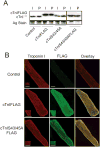
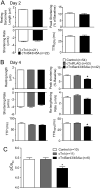
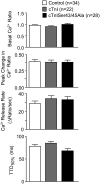
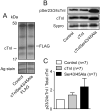
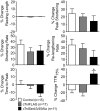
Similar articles
-
Independent modulation of contractile performance by cardiac troponin I Ser43 and Ser45 in the dynamic sarcomere.J Mol Cell Cardiol. 2015 Feb;79:264-74. doi: 10.1016/j.yjmcc.2014.11.022. Epub 2014 Dec 3. J Mol Cell Cardiol. 2015. PMID: 25481661 Free PMC article.
-
Functionally conservative substitutions at cardiac troponin I S43/45.Arch Biochem Biophys. 2016 Jul 1;601:42-7. doi: 10.1016/j.abb.2016.02.002. Epub 2016 Feb 8. Arch Biochem Biophys. 2016. PMID: 26869200 Free PMC article.
-
Functional communication between PKC-targeted cardiac troponin I phosphorylation sites.Arch Biochem Biophys. 2017 Aug 1;627:1-9. doi: 10.1016/j.abb.2017.05.019. Epub 2017 Jun 3. Arch Biochem Biophys. 2017. PMID: 28587770 Free PMC article.
-
Troponin I modulation of cardiac performance: Plasticity in the survival switch.Arch Biochem Biophys. 2019 Mar 30;664:9-14. doi: 10.1016/j.abb.2019.01.025. Epub 2019 Jan 23. Arch Biochem Biophys. 2019. PMID: 30684464 Free PMC article. Review.
-
Integration of troponin I phosphorylation with cardiac regulatory networks.Circ Res. 2013 Jan 18;112(2):355-66. doi: 10.1161/CIRCRESAHA.112.268672. Circ Res. 2013. PMID: 23329791 Free PMC article. Review.
Cited by
-
Gene transfer into cardiac myocytes.Methods Mol Biol. 2015;1299:177-90. doi: 10.1007/978-1-4939-2572-8_15. Methods Mol Biol. 2015. PMID: 25836585 Free PMC article.
-
Contribution of Post-translational Phosphorylation to Sarcomere-Linked Cardiomyopathy Phenotypes.Front Physiol. 2016 Sep 14;7:407. doi: 10.3389/fphys.2016.00407. eCollection 2016. Front Physiol. 2016. PMID: 27683560 Free PMC article.
-
Phosphorylation of protein kinase C sites Ser42/44 decreases Ca(2+)-sensitivity and blunts enhanced length-dependent activation in response to protein kinase A in human cardiomyocytes.Arch Biochem Biophys. 2014 Jul 15;554:11-21. doi: 10.1016/j.abb.2014.04.017. Epub 2014 May 9. Arch Biochem Biophys. 2014. PMID: 24814372 Free PMC article.
-
Differential protein expression and basal lamina remodeling in human heart failure.Proteomics Clin Appl. 2016 May;10(5):585-96. doi: 10.1002/prca.201500099. Epub 2016 Jan 25. Proteomics Clin Appl. 2016. PMID: 26756417 Free PMC article.
-
Independent modulation of contractile performance by cardiac troponin I Ser43 and Ser45 in the dynamic sarcomere.J Mol Cell Cardiol. 2015 Feb;79:264-74. doi: 10.1016/j.yjmcc.2014.11.022. Epub 2014 Dec 3. J Mol Cell Cardiol. 2015. PMID: 25481661 Free PMC article.
References
-
- Gordon AM, Regnier M, Homsher E. Skeletal and cardiac muscle contractile activation: tropomyosin “rocks and rolls”. News Physiol Sci. 2001;16:49–55. - PubMed
-
- Davis J, et al. Designing heart performance by gene transfer. Physiol Rev. 2008;88(4):1567–651. - PubMed
-
- Noland TA, Jr, Raynor RL, Kuo JF. Identification of sites phosphorylated in bovine cardiac troponin I and troponin T by protein kinase C and comparative substrate activity of synthetic peptides containing the phosphorylation sites. J Biol Chem. 1989;264(34):20778–85. - PubMed
-
- Noguchi T, et al. Thin-filament-based modulation of contractile performance in human heart failure. Circulation. 2004;110(8):982–7. - PubMed
Publication types
MeSH terms
Substances
Grants and funding
LinkOut - more resources
Full Text Sources
Other Literature Sources
Molecular Biology Databases
Research Materials
Miscellaneous

